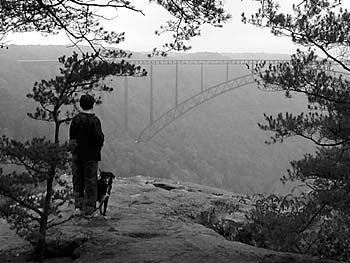
 |
Summer 2003 |
|
An interview with Denise Giardina ADA: Becoming Accessible From the Director A convergence of printmakers and potters Monoprints of Barbara Marsh Wilson Interview with Mark Wolfe |
Through the Mystery Hole
|
 |
Denise Giardina, with her dog Phyllis, stands at the edge of the New River Gorge, one of the settings for Fallam’s Secret. |
A wormhole is a space tunnel where time behaves differently, in theory. The Mystery Hole is an actual tourist attraction near the New River Gorge in Ansted. “I haven’t been in it for years,” says Giardina during an interview in the back of Taylor Books in downtown Charleston. “It’s a room built underground. I think it’s built on its side, but you don’t know that when you go in because you twist and turn. So when you’re in there, they sit you down on a bench, but you’re really sitting on your back. Your sense of gravity is all messed up because it’s built sideways. So they do these things like put a ball on a ramp and it looks like it’s rolling uphill. When you start to get up, you really have to work hard to stand back up again, because what you’ve really been doing is lying on your back without realizing it.”
Asked how she came up with the plot device, Giardina says, “I’ve been toying with the idea of a fire for a long time.” There had been a fire near Fayetteville in 1945 in which the children were assumed to have perished, though their bodies were never found. “I had almost given up about writing something on that mysterious fire. I tried to write a play about it. Then I was going to make a movie about it, but it just wasn’t there.”
Then she had the idea of linking other story elements she had been considering: Time travel and the time period of the 1600s.
In a sense Fallam’s Secret is historical fiction, because Giardina did research the period for such authentic details as the position of major-general that character Noah Fallam holds in 1657. But the novel is a fantasy version of history. Giardina changed Fayetteville to Lafayette, and moved the Mystery Hole to the other side of the gorge. “There’s more humor,” too, she says. “The first thing Lydde notices is how bad everything smells. Normally, in a historical novel, you wouldn’t note that.
“The others were fun, in a sense, because they were very satisfying,” Giardina says of her previous books. “But this one was just pure fun to write.” The experience of Fallam’s Secret took its author by surprise. Good King Harry, Giardina’s first novel, took two years to complete. Storming Heaven took two, and The Unquiet Earth required four years. After spending six years working on Saints and Villains, “I thought, ‘Maybe eight years from now I’ll have another novel.’”
But in six months, Fallam’s Secret was done, and she’s already well into the second book in the series. “I’m really writing this book kind of like when I used to tell stories to myself as a kid. When I was on a car trip, I would make up adventure-type stories. I would make myself be the protagonist. It’s almost like I’m pretending that I’m her. It’s fun in that way. I’m just having a ball.” As she speaks, her dark eyes sparkle as brightly as a child’s upon receiving an unexpected present.
Mountaintop removal, one of her campaign issues in the past gubernatorial campaign, also shows up in this new novel. For other plotlines in the four- to five-book series, she’s also considering exploring the Underground Railroad during the Civil War and what she says amounted to ethnic cleansing of the Tutelo Indians by other Native American tribes.
As a writer with a Master’s degree in divinity, she also explores the nether territory of life after death. “Theologians and physicists are having some dialogue about this idea that when we die we go to another dimension. I even heard a sermon preached in England at Chichester Cathedral when I was researching the Bonhoeffer book. The dean of the cathedral preached a sermon about heaven and he said he thought it was another dimension. I was thinking about wormholes and what if, when we die, we go through wormholes?”
She excuses herself to get more coffee and returns to explain how she also is exploring the idea of the kingdom of God. “I’m kind of reacting to the right-wing fundamentalist idea about the end times. I think it’s a misinterpretation,” she says, drinking from a mug that reads, “A Book is a Terrible Thing to Ban.”
“I’m exploring the idea that in Jesus’s first sermon he talked about the kingdom of God being present now. It’s coming, but it’s also present. It’s a paradox. One of my characters gives a sermon about that. One idea I have is that these wormholes are kind of the kingdom of God making these little cracks in the fabric of reality.”